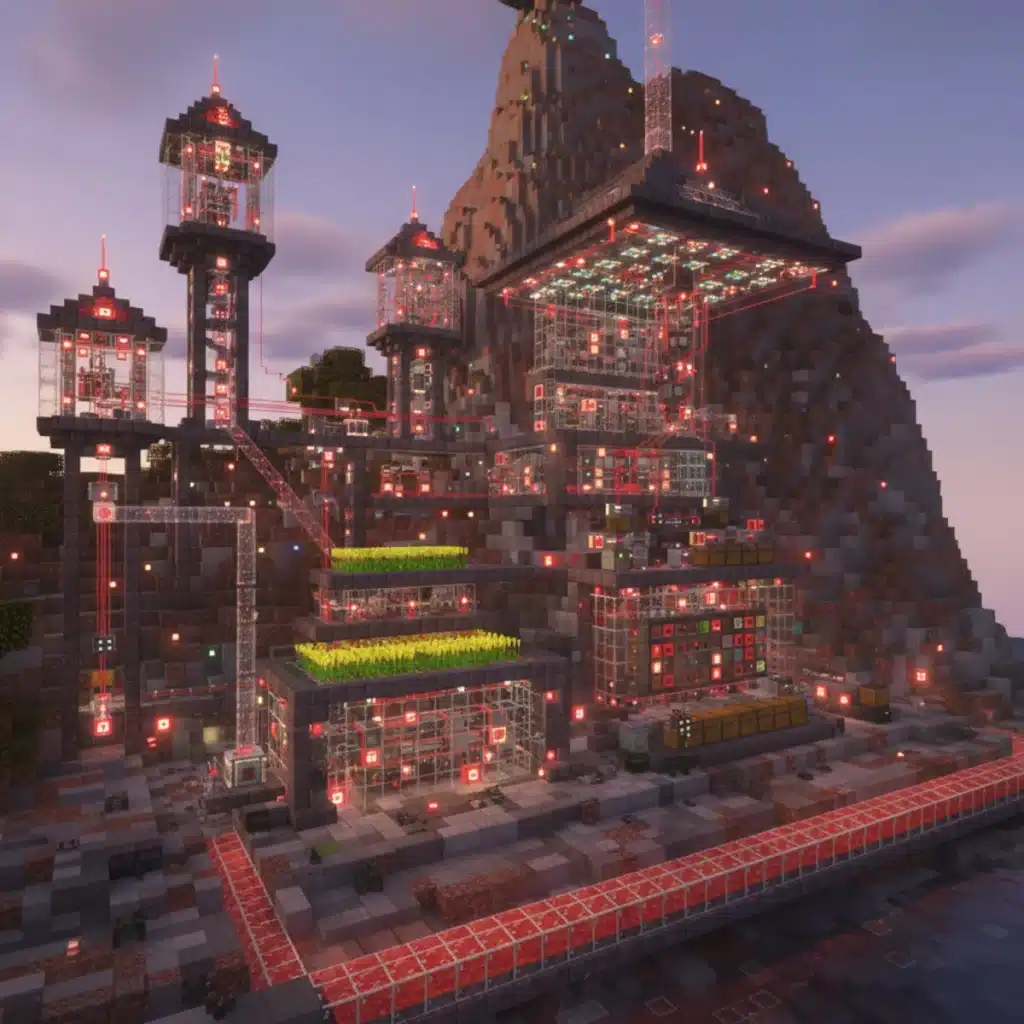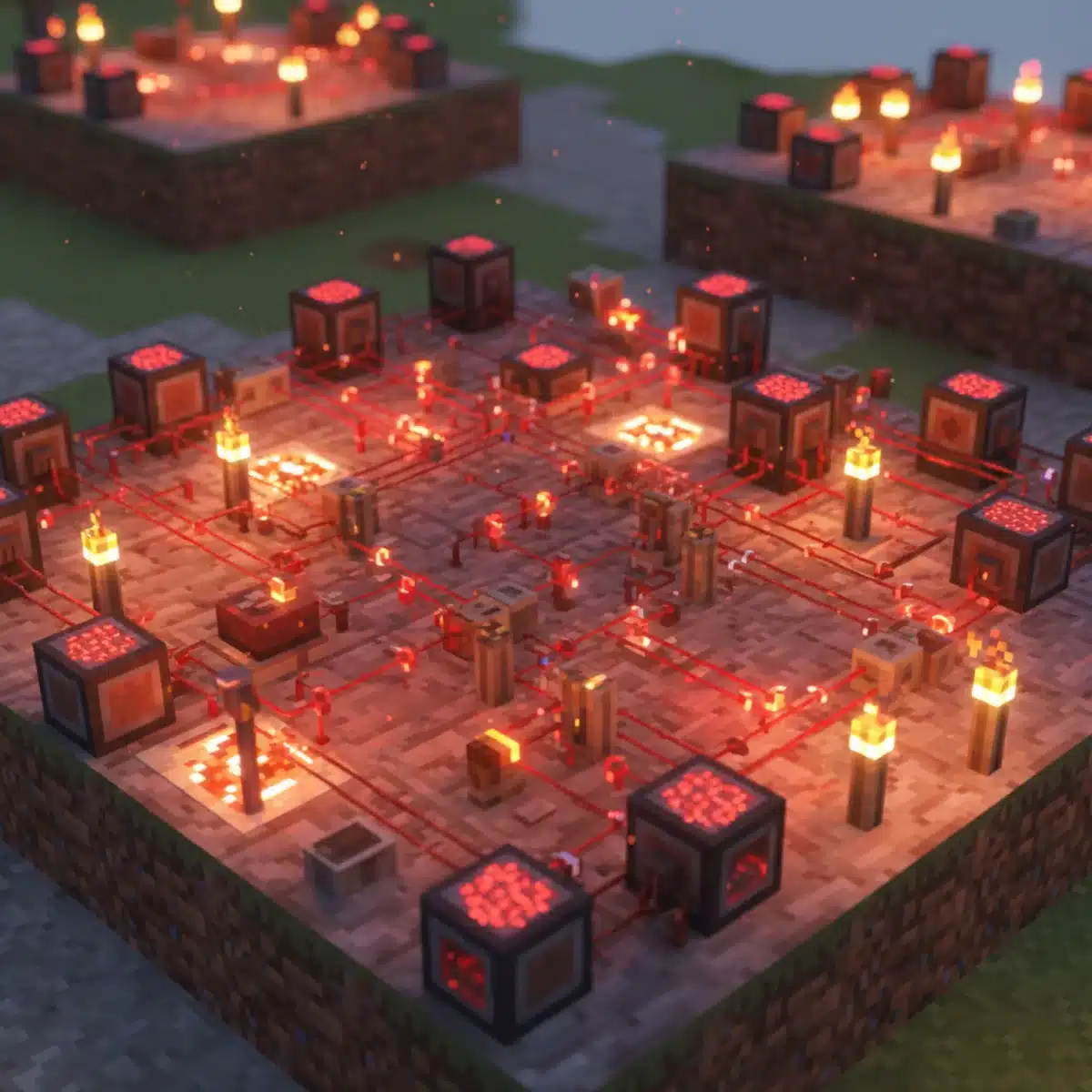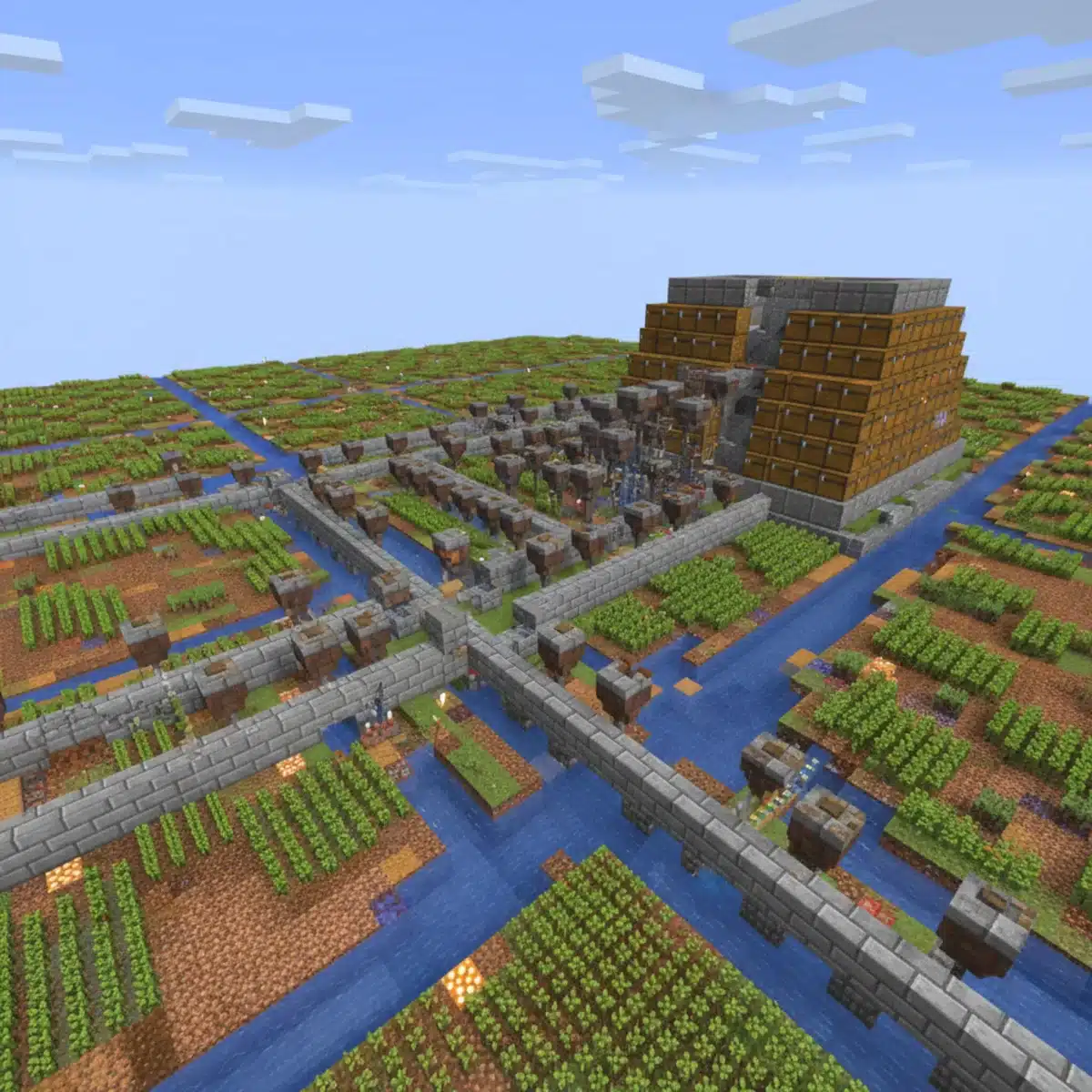Minecraft Redstone: 5 Advanced Automation Techniques for 2025

Advertisements
Mastering advanced redstone automation in Minecraft transforms your base into an efficient, self-sustaining hub, utilizing complex circuits for everything from farming to sophisticated storage systems and automated defenses, enhancing your gameplay significantly.
Are you ready to elevate your Minecraft experience? In 2025, mastering Minecraft Redstone Circuits: 5 Advanced Techniques to Automate Your Base is not just a luxury; it’s a game-changer. Redstone, the digital logic component of Minecraft, allows players to create sophisticated mechanisms that automate tedious tasks, enhance defense, and streamline resource management, turning your humble dwelling into a futuristic fortress.
Anúncios
Understanding the Fundamentals of Advanced Redstone
Before diving into complex builds, a solid grasp of redstone’s core principles is essential. Advanced automation relies on understanding how redstone signals propagate, how components interact, and how to manipulate these interactions to achieve desired outcomes. It’s about moving beyond simple switches and doors to designing intricate systems that mimic real-world electronics.
Advanced redstone begins with signal manipulation. This involves using repeaters to extend signals, comparators for detecting container contents or manipulating signal strength, and observers for detecting block changes. These components, when combined creatively, form the backbone of highly efficient and compact circuits.
Anúncios
The Role of Observers and Comparators
Observers are crucial for creating automated farms and detection systems. They output a redstone pulse when the block they are observing changes state. Comparators, on the other hand, are invaluable for smart storage and complex logic, as they can measure the fill level of containers or compare signal strengths. Integrating these into your designs opens up a world of possibilities for dynamic automation.
- Observers: Detect block updates, perfect for automated crop harvesting.
- Comparators: Essential for item detection, sorting, and advanced logic.
- Repeaters: Extend signal range and introduce delay for timing mechanisms.
- Pistons: The workhorses of automation, used for moving blocks and items.
Mastering these foundational elements allows you to think beyond basic on/off switches. It enables you to design circuits that respond intelligently to environmental changes or player actions, laying the groundwork for truly advanced automation within your Minecraft world. The precision and timing these components offer are paramount for successful, large-scale redstone projects.
Technique 1: Fully Automated Multi-Item Sorting System
Imagine never having to manually sort your chests again. A fully automated multi-item sorting system is a cornerstone of any advanced Minecraft base. This technique involves using an array of hoppers, comparators, and redstone torches to direct different items into specific storage containers. It’s an intricate but incredibly rewarding build that saves countless hours.
The basic principle involves a main input line of hoppers feeding into a series of item filters. Each filter uses a comparator to detect a specific item, pulling it out of the main stream and into its designated chest. Excess items or those not recognized by a filter continue down the line to a general storage or incinerator system.
Building Efficient Item Filters
An efficient item filter typically consists of a hopper feeding into another hopper that’s locked by a redstone torch. A comparator reads the lower hopper, and when a specific item is detected and reaches a certain stack count, it unlocks the hopper, allowing the item to pass through. This setup prevents items from getting stuck and ensures precise sorting.
- Hopper Chains: The primary method for transporting items through the system.
- Comparator Logic: Detects specific items and their quantities within hoppers.
- Redstone Torches: Used to lock and unlock hoppers, controlling item flow.
- Storage Units: Chests or barrels designated for each item type, often in large arrays.
The beauty of this system lies in its scalability. You can expand it to sort dozens, even hundreds, of different items. Planning is key: consider the types of items you frequently acquire, how many you need to store, and where you want them located. A well-designed sorting system reduces clutter and makes resource management effortless, letting you focus on more creative endeavors.

Technique 2: Self-Replenishing Automated Farms
Automated farms are a staple of redstone automation, but self-replenishing versions take efficiency to a new level. These farms not only harvest crops or resources automatically but also replant or regenerate them without player intervention. This is particularly useful for food, wood, or even certain mob-based resources.
For crop farms, observers are strategically placed to detect when crops grow to maturity. This triggers pistons to break the crops, and a water stream or hopper system collects them. The key to self-replenishing is often integrated villagers who replant crops, or specialized mechanisms for tree farms that automatically plant saplings after harvesting wood.
Designing a Fully Automatic Tree Farm
A fully automatic tree farm is a marvel of redstone engineering. It typically involves a planting mechanism (often dispensers with saplings), a growth accelerator (like bonemeal dispensers), a harvesting mechanism (pistons breaking logs), and a collection system. Observers detect tree growth, triggering the pistons to push the wood into a collection area. The saplings are then replanted, creating a continuous cycle.
- Piston-Based Harvesting: Efficiently breaks blocks like logs, crops, or even stone.
- Water/Hopper Collection: Gathers harvested items and transports them to storage.
- Villager Mechanics: Can be leveraged for automatic replanting of certain crops.
- Bonemeal Dispensers: Accelerate crop and tree growth for faster yields.
These farms require careful timing and precise placement of components to ensure seamless operation. The goal is a closed-loop system where resources are produced, harvested, and sometimes even processed without any manual input. This frees up your time for exploration, building, or tackling more challenging aspects of the game, knowing your essential resources are constantly replenishing.
Technique 3: Advanced Mob Grinders and Item Processing
Mob grinders are excellent for gaining experience and rare drops, but an advanced grinder integrates item processing for maximum efficiency. This means not only killing mobs but also automatically sorting their drops, smelting specific items, and even composting unwanted loot. This transforms a simple grinder into a powerful resource generation facility.
An advanced mob grinder might use crushing pistons or fall damage for mob elimination, followed by a sophisticated hopper system to collect all drops. Comparators then sort items, sending raw materials to furnaces (powered by another redstone circuit for fuel efficiency) and unwanted items to a compost system or void. XP can be funneled to a specific collection point.
Automating Smelting and Composting
Automating smelting involves feeding raw materials into furnaces with hoppers and supplying them with fuel, often from an automated charcoal farm or lava source. The smelted items are then collected by another set of hoppers. Composting unwanted organic materials in composters can generate bonemeal, which can then be fed back into automated farms, creating a sustainable cycle.
- Mob Elimination: Utilizes fall damage, crushing pistons, or even lava blades.
- Item Collection: Hoppers and water streams efficiently gather all drops.
- Automated Smelting: Furnaces with hopper input/output and automated fuel delivery.
- Composting Systems: Convert organic waste into valuable bonemeal.
The integration of these processing systems turns an ordinary mob grinder into an incredibly valuable asset. You’re not just getting drops; you’re getting processed goods and even generating secondary resources like bonemeal. This level of automation significantly boosts your base’s self-sufficiency and overall resource output, making late-game progression much smoother.
Technique 4: Redstone-Powered Transportation Networks
Moving items and players efficiently across your sprawling base or between distant outposts is crucial. Redstone-powered transportation networks, including advanced minecart systems and water-based item conveyors, offer unparalleled convenience and speed. These systems can be designed to be fully automatic, dispatching carts or items only when needed.
For minecart systems, this involves detector rails, powered rails, and sophisticated logic to manage multiple carts, prevent collisions, and ensure they reach their correct destinations. For item transport, complex water streams, soul sand elevators, and slime block launchers can move items vertically and horizontally over long distances, feeding directly into sorting systems.
Smart Minecart Dispatch Systems
A smart minecart dispatch system uses redstone logic to call carts, send them to specific stations, and return them to a central hub when empty. This might involve a selection panel at each station, triggering a circuit that prepares and sends a cart. Detector rails at the destination confirm arrival and trigger the cart’s return or unloading sequence.
- Powered Rails: Provide propulsion for minecarts over long distances.
- Detector Rails: Trigger redstone signals upon minecart passage for automation.
- Water Streams & Soul Sand: Efficiently move items, especially vertically.
- Slime Block Launchers: Can launch items or players across gaps.
These transportation networks are not just about speed; they’re about seamless integration. Imagine a farm automatically sending its harvested goods to your central storage, or a player transportation system that takes you from your main base to your mining outpost with a single button press. The efficiency gained from a well-designed redstone transport system is immense, connecting all parts of your world.

Technique 5: Integrated Security and Defense Systems
Protecting your base from hostile mobs and even other players (in multiplayer servers) is paramount. Advanced redstone allows for integrated security and defense systems that range from automated perimeter defenses to hidden entrances and alarm systems. These systems are designed to detect threats and respond autonomously, giving you peace of mind.
This can include motion-activated traps using tripwires or pressure plates connected to dispensers firing arrows or splash potions. Hidden doors and secret passages, controlled by complex redstone puzzles or hidden switches, add an extra layer of protection. Automated lighting systems can also deter mob spawns around your base.
Designing a Secure and Hidden Entrance
A secure and hidden entrance is a hallmark of advanced redstone. This often involves piston doors concealed within terrain, activated by a specific sequence of levers, buttons, or even a hidden item frame. The redstone logic behind these can be quite complex, ensuring only those who know the secret can gain entry, while maintaining a completely camouflaged exterior.
- Motion Sensors: Tripwires and pressure plates to detect intruders.
- Automated Traps: Dispensers firing projectiles or pistons activating pitfalls.
- Hidden Piston Doors: Concealed entrances for enhanced base security.
- Alarm Systems: Noteblocks or bells triggered by detection circuits.
An integrated security system goes beyond simple walls. It actively defends your base, detects threats, and keeps your valuable resources safe. Combining these elements creates a fortress that is both formidable and discreet, allowing you to focus on building and exploring without constant worry about external dangers. The satisfaction of a perfectly concealed and automated defense is truly unmatched.
| Key Technique | Description |
|---|---|
| Automated Sorting | Sorts multiple items into designated chests using hoppers and comparators, eliminating manual sorting. |
| Self-Replenishing Farms | Automatically harvests and replants crops or trees, ensuring a continuous supply of resources. |
| Advanced Mob Grinders | Integrates mob elimination with automated item collection, sorting, and processing for efficiency. |
| Redstone Transport | Creates automated minecart and item conveyor systems for efficient movement of goods and players. |
Frequently asked questions about advanced redstone automation
Common mistakes include incorrect timing with repeaters, signal strength issues, and improper component placement leading to signal interference. Always double-check your wiring and test small sections of your circuit before integrating them into a larger system to troubleshoot effectively.
YouTube tutorials from experienced redstone engineers are invaluable. Experimenting in creative mode, studying existing complex builds, and joining redstone communities online can also provide deep insights and practical knowledge for aspiring redstone masters.
Beyond redstone dust, key components include repeaters for signal extension and delay, comparators for item detection and logic, observers for block change detection, pistons for movement, and hoppers for item transport. Understanding these is fundamental.
Absolutely! While these techniques often require significant resource gathering and careful planning, they are entirely feasible in survival mode. They are designed to make survival gameplay more efficient and enjoyable by automating tedious tasks and securing your base.
To reduce lag, aim for compact designs, minimize rapidly updating blocks, and use components efficiently. Avoid unnecessarily long redstone lines and excessive use of entities like item frames or armor stands near complex redstone builds. Consider using simpler alternatives when possible.
Conclusion
Embracing these Minecraft Redstone Circuits: 5 Advanced Techniques to Automate Your Base in 2025 will fundamentally transform your gameplay. From building intricate sorting systems that manage your inventory with precision to creating self-sustaining farms that continuously yield resources, redstone offers endless possibilities. Investing time in understanding and implementing these advanced techniques will not only make your base more efficient and secure but also unlock new levels of creativity and problem-solving in your Minecraft world. The future of Minecraft automation is here, and it’s powered by your ingenuity with redstone.





